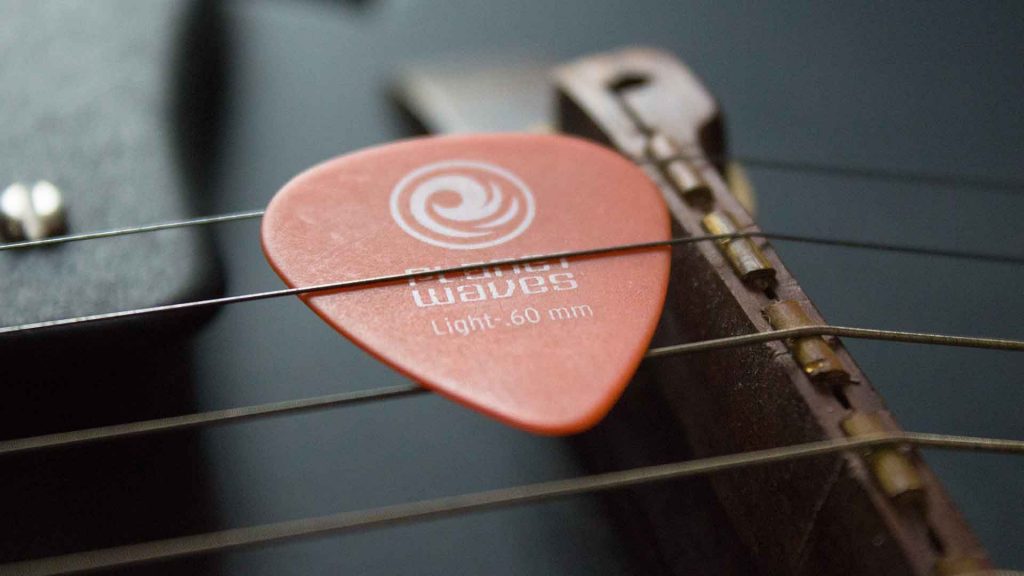| 1. D’Addario | 2. Jim Dunlop | 3. Fender |
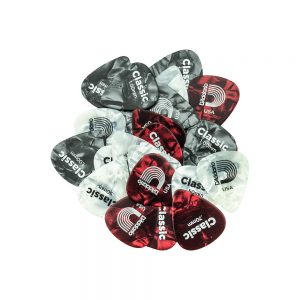 |
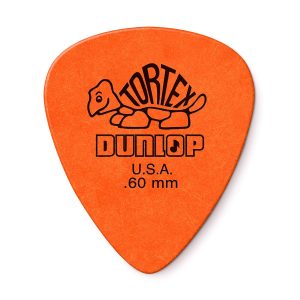 |
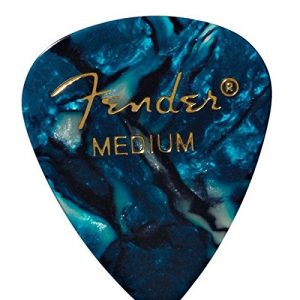 |
| CHECK PRICE! | CHECK PRICE! | CHECK PRICE! |
Selection of the best guitar pick largely influences and improves the quality of sound produced by a guitarist. A lot of specifics related to the quality of music depends on the kind and quality of picks that are being used.
If you are also contemplating about choosing the best picks for your guitar but don’t know how to find them, then this guide will come to your great help.
In this guitar picks buying guide, we have given you complete information about what accessories like guitar picks are, why are they so essential for your music production, and how to choose the best ones. We have also enlisted top 15 guitar picks that have been making rounds at present.
CHECK THE TOP GUITAR PICKS NOW!Hope this guide will help you find the best plectrums for your guitar, and help you produce the best quality music that would be loved by all.
Why Are Guitar Picks Essential?
A guitar pick is a miniscule object that changes the entire sonic range of a guitarist’s music. Basically, guitar pick is a tiny device that guitarists use to move the strings of the guitar.
While moving the strings with fingers or thumb is also a choice available for guitarists, but this can hurt their fingers and may compromise with the quality of sound being produced.
The speed of a guitarist’s playing, along with the clarity and tone of the music produced, be it an electric or an acoustic guitar, depends considerably on the kind and quality of the guitar pick the guitarist is using.
A small thing that is almost invisible in the hands of a guitarist serves to be an essential item in the quality of music being played.
People might often think that all guitar picks are designed and made in the same way, due to which selecting the best ones is not a matter of great concern. But in reality, choosing the guitar picks requires proper thought and consideration in the field of music and guitars.
People who pay attention to the minute details of music understand the importance of picking a suitable and good quality plectrum only. All in all, picks greatly affect the overall dynamic range and every singular tone of the music being played by a guitarist.
Factors To Look For When Buying The Best Guitar Pick
As said earlier, choosing the best guitar pick from such a wide range of products available in the market is a matter of experience.
You need to take into consideration certain points and guidelines that highlight the qualities of the best guitar picks available out there.
Finding the most suitable guitar pick for your purpose is an extensively experimental process. But experiments must also be done under certain regulations and guidelines.
A hit and trial method is seldom efficient and can hamper the playing capabilities and performance of a musician in real time.
The best pick is not chosen depending on the way it looks, but also because of its various functionalities and applications.
There are a number of factors associated with the selection of a plectrum that must be looked into while choosing from the best picks. Some of the most important factors are:
1. Material
During the late 19th century, tortoise shell material used to be the most common material used for making guitar picks. Certain species of turtles were used for the production of this kind of material.
But after the ban in 1973, owing to the endangerment of certain turtle species, celluloid material was started being used in the industry.
In today’s time, the most common material used for manufacturing plectrums are nylon, celluloid, and Delrin/Acetal (polyoxymethylene thermoplastic), along with a wide range of other materials that impart individual and differential characteristics to different types of guitar picks.
The different kinds of materials affect the grip and tone of the music in different ways. Some of the common materials being used for their making include:
- Celluloid: The most common material used for making guitar picks is celluloid. Originally introduced as a replacement for ivory, this material provides great crispness and a bright attack, and is suited for acoustic playing and vintage tones.
- Nylon: Nylon is another commonly used material for making guitar picks. They are often seen being used by famous guitarists like Jimmy Page, David Gilmour etc. These picks are usually very flexible with a smooth texture and produce a warm tone due to their decreased rigidity. Although these picks tend to wear out quickly, some of the best guitar picks in the world are made out of this material.
- Tortex: This is made from DuPont Delrin, originally introduced as a replacement for tortoiseshell. This material produces a mid-range, balanced, and well-rounded tone from the guitar. Also known as acetal raisin, it has a mild impact on the tone without cutting much warmth. It has a focused application without much influence on the high-end frequencies.
- Ultex/Ultem: This material, which also mimics the tortoiseshell, offers more rigidity than Tortex, and is more durable as well. It has a stronger attack and high-end response, and it is a bit more slippery than Tortex. It is most suitable for players who play a tighter sound emphasizing on the high-end.
- Metal: Various metals like stainless steel, bronze, and copper are also pick making materials that make for some of the best guitar picks for beginners. These allow incredibly fast picking, with a compact harmonic response and a bright tonality. Guitarists like Brian May and Billy Gibbons have been known to use these materials occasionally.
- Wood: Different types of wood are used to produce different types of tones. Wood generally produces a warm tone with a high responsiveness based on the pick attack.
- Other materials: There are other materials like animal bones, horns and hide, acrylic carbon fiber, glass and felt that are used in plectrum making. Since they are made of exotic materials, they are often more expensive than the other picks and are less commonly used.
All that being said, the kind of music you are playing and the kind of guitar you are using largely influence the guitar picks you would choose.
2. Size
The size of the pick is also important in determining its applications and usage. The kind of instrument being played is essential to deciding the size of the pick which would be the most suitable. Guitar picks vary in size and shape, each suited for various occasions and preferences of musicians.
Smaller picks are used by musicians who prefer getting very close to the strings while playing, as small picks effectively decrease the distance between the hands and the strings, thereby facilitating swift hand techniques such as palm muting or fingerpicking.
The dexterity of the musical tone is reliant on the size of the pick, which is why many strummers and acoustic layers use large picks, while jazz and metal guitarists prefer smaller picks that have a pointed design.
3. Shape
The shape of a guitar pick determines its surface area, which is considered to determine the ease of transition between the strings. Guitar picks are available in a variety of shapes, and most guitar players prefer the shape most suited for the kind of instrument they are playing and also the kind of music they want to produce.
- The most common variation of guitar picks is the conventional triangular teardrop shaped pick. It is the standard shape used for making most of the guitar picks.
- Triangle picks and shark fin picks are also pretty popular in the guitar world.
- Some of the other popular shapes of guitar picks are the jazz, triangle and odd-shaped picks. There are also customized picks that the guitarists can choose to customize according to their preference and convenience.
The shape of the guitar picks is based mainly on the sharpness of the striking surface. While solo guitar players prefer sharp pointed picks that have a stronger attack and a brighter tone, the rounded points in some guitar picks are more suitable for softer and mellower tones, and are preferred mainly by strummers.
4. Edge
Along with the shape, the edges of the picks are also important in the kind of music being produced.
While smooth-edged picks are the most common type of picks used by guitarists, beveled edges of guitar picks are mostly preferred by guitar players who like to play fast. Such edges glide off the string more easily and create less friction while making fast playing easier and more efficient.
5. Gauge
The gauge of a guitar pick refers to its thickness. After choosing the preferred shape, size and material of the pick, the next most important thing to do is to choose the gauge of the pick. After all, the pick’s largely decides the quality and tone of music being produced.
The best guitar picks come in a wide range of thicknesses. Ranging from extra thin to extra thick, the picks directly influence the tone and quality of music.
Choosing the thickness of a pick largely depends upon the style of playing and preferences of a guitarist. The softer the pick, the milder the tone; the harder the pick, the brighter and louder the tone.
Different Gauge Types Include
- Extra thin gauge: Anything thinner than 0.44 mm is known to be extra thin when it comes to guitar picks. This kind of a pick is ideal for strummers.
- Light/thin gauge: Ranges between 0.45 to 0.69 mm. Some of the best picks are made using this measurement.
- Medium gauge: The range of this kind of pick is from 0.7 mm to 0.84 mm, and it is among the most common forms of plectrums. Guitar picks for beginners follow this standard thickness in most cases.
- Thick/ heavy gauge: Another extremely popular gauge of guitar picks is within the range of 0.85 to 1.2 mm. These are also widely popular in the guitar world.
- Extra thick/ extra heavy gauge: Anything above 1.5 mm is known as extra thick or extra heavy gauge for a guitar pick. Only a few leading guitarists might choose this for playing their guitar.
The heavier or thicker guitar picks provide a good midrange scope with a chugging tone. The thinner picks do not strike the strings hard enough and are hence suitable for softer tones.
The full dynamic range is explored by heavier picks, while rhythm players usually prefer thinner picks, as they offer more flexibility and seamlessness.
On the other hand, medium picks can be used for a diverse range of musical involvements due to their versatility. The heavier picks are mostly meant for lead guitarists who require a strong attack.
6. Texture
The texture of the pick surface plays a crucial role in deciding the grip, and does influence the quality of the music produced.
Although choosing the texture of a guitar pick is completely dependent upon the kind of music the guitarists play and their style of playing, it also depends on the kind of music being made.
While smooth and slippery picks are used to produce a more neat and natural tone, rough picks add more richness and vividness to the tone of the music.
All in all, smooth and round edges would help in producing a warmer tone that is purer and softer, while sharp edges are used for stronger attack and a brighter tone.
The texture of the surface also increases or decreases the friction of the pick with your fingers and affects how nicely the pick fits and stays between your fingers while playing.
Most picks are specifically designed with built-in grip for added assistance to the guitarist. A layer of a certain material to increase friction is used by many brands on the surfaces of the best guitar picks in the market.
Acrylic material is also used for the same purpose as a form of customization to increase the grip.
7. Kind Of Music Produced
The kind of music that is being produced largely influences the choice of your guitar pick. If you want to produce soft music with your guitar, then you will need to choose a pick that is made of soft material and has a soft surface.
But if you want to produce louder, brighter music, then choose a harder pick with rough surface.
8. Price
As compared to the price of your guitar, the price of guitar picks is negligent. You can easily find packs of 12, 25, or 75 guitar picks in extremely low prices.
Available in a variety of colors and designs, you can choose the one as per your personal preference or as per the color of your guitar.
An even combination of all the above-mentioned factors must be taken into consideration while choosing the best pick for yourself. Here, we have enlisted a few top guitar picks available out there in the market.
Here is a compilation of 15 top guitar picks available in the market right now. The list has been carefully curated while keeping in mind several factors to suit various kinds of players and music qualities, and to serve the best value for money.
Top 15 Best Guitar Picks 2022
1. D’Addario
 This is one of the best choices available in the market when it comes to finding a standard solution for guitar picks. It comes in an assorted pack of 25 and is one of the most popular guitar picks available in the market.
This is one of the best choices available in the market when it comes to finding a standard solution for guitar picks. It comes in an assorted pack of 25 and is one of the most popular guitar picks available in the market.
These are industry standard products and are extremely affordable being priced under $8 for the 25 pack.
D’Addario is reputed for their quality products in the market and these standard shaped picks are a testament to their reputation.
Made of celluloid, these medium gauge picks are ideal for strumming and plucking purposes. Being one of the most versatile picks in the market, they also make ideal guitar picks for beginners.
Pros
- Low-priced
- Pack contains assorted color options
- Medium gauge
- Versatile, suitable for various genres and styles
- Environment friendly packaging
Cons
- Wear down quickly
2. Dunlop Tortex
 The Dunlop Tortex is one of the most consistently popular picks over the years. It is made up of a material that mimics tortoiseshell, and has an outstanding texture, feel and performance.
The Dunlop Tortex is one of the most consistently popular picks over the years. It is made up of a material that mimics tortoiseshell, and has an outstanding texture, feel and performance.
This pick has been preferred by professionals as well as novices over the years because of the standard size and feel of the picks.
There are a variety of pack sizes available, and the 72 pack is available at a cheap price under $13. This makes this one of the most affordable packs of guitar picks out there.
Pros
- Standard gauge
- Different pack sizes available
- Different colors available
- Visually attractive
- Longer life than usual
- Suitable for a variety of genres and music styles
Cons
- The design is too plain and boring
- Too big for strumming
3. Fender
 These celluloid picks from the house of Fender come in a variety of sizes and colors, with the ocean turquoise being one of the most attractive shades.
These celluloid picks from the house of Fender come in a variety of sizes and colors, with the ocean turquoise being one of the most attractive shades.
They come in the standard teardrop shape and a range of other attractive designs. The player can choose the gauge of the pick according to his instrument and style of playing.
These picks operate in a similar way as other standard shaped picks. They offer increased variety in playing, and are suitable for guitars, mandolin and bass guitars as well.
They are extremely convenient and have impressive playability as said by several people who have used the picks.
Pros
- Easy playability
- Flexible
- A variety of colors and designs available
- Standard 351 shape
- Versatility
Cons
- Pack of 12 is too less, could be available in bigger packs
4. ChromaCast
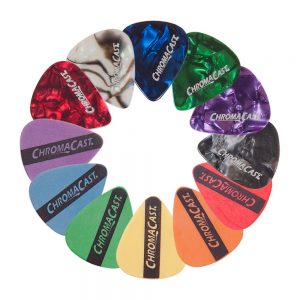 These are classic guitar picks from ChromaCast, having a wide body and rounded tip. Ranging from extra thin gauge to thick gauge, these picks offer a wide range of thickness for various styles of playing.
These are classic guitar picks from ChromaCast, having a wide body and rounded tip. Ranging from extra thin gauge to thick gauge, these picks offer a wide range of thickness for various styles of playing.
Made of celluloid, these are one of the best guitar picks for beginners, as they are extremely easy to hold and control due to their smoothness and malleability.
These come in a standard 12-pack at really affordable price of around $3.
Pros
- Really inexpensive
- Easy to control
- Multiple sizes available
- Versatile
- Beautiful looks
- Assortment of colors available
Cons
- Slightly slippery
5. Fender Premium
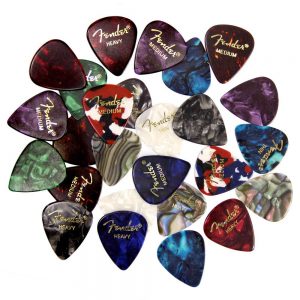 This Fender special premium picks are standard style picks made of celluloid. You can buy these in packs of 12, 24 or 48, that consist of all gauges of picks ranging from thin and medium to thick.
This Fender special premium picks are standard style picks made of celluloid. You can buy these in packs of 12, 24 or 48, that consist of all gauges of picks ranging from thin and medium to thick.
They have a regular attack with a bright tone, as a result of which they can produce warm music tone from the guitar.
Available in a wide range of colors and designs, you can choose the one that best suits your personality and guitar.
Pros
- Made of celluloid
- Multiple gauges in the 24 pack
- Versatile range of capabilities
- Available in multiple colors
Cons
- Beginners may find it difficult to control due to a little slippery surface
6. Dunlop PVP102
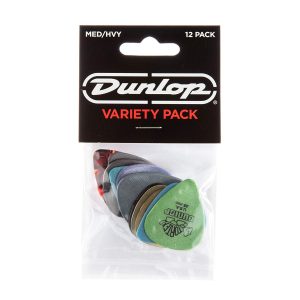 With over 50 different types of picks in the market, Dunlop is one of the most reputed brands producing guitar picks. The PVP102 Pick is one of the best picks in the industry owing to its amazing combination of excellent build quality and affordable prices.
With over 50 different types of picks in the market, Dunlop is one of the most reputed brands producing guitar picks. The PVP102 Pick is one of the best picks in the industry owing to its amazing combination of excellent build quality and affordable prices.
It is available in assorted medium and heavy variety packs of 12. It is suitable for both electric and acoustic guitars and come in a variety of sizes and textures that provide sharp and accurate tones. The pack of 12 is so reasonably priced at less than $4.
Pros
- Highly affordable
- Variety of sizes available
- Assorted pack of 12
- Attractive colors
Cons
- Prone to easy wear and tear
7. Dunlop 44R.60
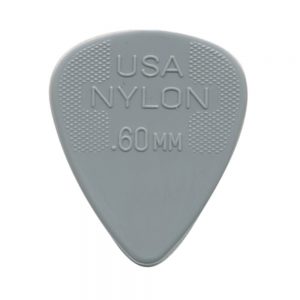 These picks are made up of high quality nylon material and have a molded tactile gripping surface that provides excellent grip. This product comes in packs of 12 and 72 and are pretty inexpensive. The pack of 72 can be purchased within $15.
These picks are made up of high quality nylon material and have a molded tactile gripping surface that provides excellent grip. This product comes in packs of 12 and 72 and are pretty inexpensive. The pack of 72 can be purchased within $15.
These are extremely sleek, light and provide excellent grip, thereby they are ideal for heavy strumming.
Pros
- Nylon standard material
- Available in different sizes
- Sleek and light
- Available in 12 and 72 packs
- Reasonably priced
Cons
- Design is plain and boring
- Wear down quickly
8. Jim Dunlop 471R3C Jazz III
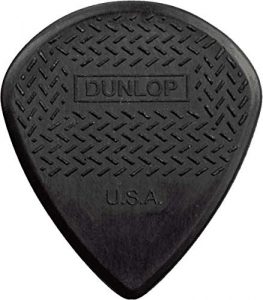 One of the best acoustic guitar picks in the market, these picks are nylon jazz style picks with carbon fiber addition. Dunlop’s Max-Grip technology is seen in these picks to improve the grip. Available in different sizes, the picks are renowned for their sharpness and durability.
One of the best acoustic guitar picks in the market, these picks are nylon jazz style picks with carbon fiber addition. Dunlop’s Max-Grip technology is seen in these picks to improve the grip. Available in different sizes, the picks are renowned for their sharpness and durability.
They are available in 6 and 24 picks bags and are one of the best choices for guitar picks. They are efficient during high speed playing and maintaining the little details.
Pros
- Made of nylon with carbon fiber
- Extra grip
- Small size
- Suitable for fast playing styles
Cons
- A little pricey than others
- Boring design
9. Best
 It is often said in the guitar world that you can never have enough guitar picks. This pack of 100 celluloid picks is one of the best choices that any musician can make.
It is often said in the guitar world that you can never have enough guitar picks. This pack of 100 celluloid picks is one of the best choices that any musician can make.
It offers a wide variety of shapes, sizes, materials and gauges of picks catering to all the needs and references and various styles of playing.
The wide body and round tip of the picks give a good fitting on the finger. The celluloid material used to make these picks provides extreme durability and flexibility. If you are not satisfied with the picks, the company offers full refund of your money.
Pros
- Variety of shapes and sizes included in the pack
- Versatile
- Suitable for various genres and styles
- Value for money
- Available in a variety of colors and designs
- Fit the fingers well
- Durable and long lasting
Cons
- Some of the picks have poor build quality
10. Art Tribute Vincent Van Gogh
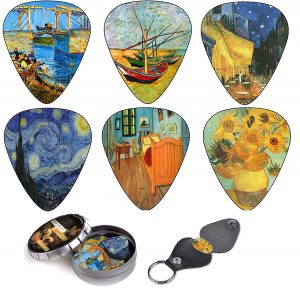 These are medium gauge picks (0.71 mm) that come in packs of 12, packed in a beautiful tin-box with unique stocking stuffer. These are made of standard celluloid material, which ensure durability, flexibility and good looks.
These are medium gauge picks (0.71 mm) that come in packs of 12, packed in a beautiful tin-box with unique stocking stuffer. These are made of standard celluloid material, which ensure durability, flexibility and good looks.
The picks have beautiful art designs imprinted on them, which make them unique and attractive. A clack box comes with this pack, in which you can store your picks and keep in your pocket. A leather pick holder also comes, that can securely hold your pick.
Pros
- Excellent gift item for guitar lovers
- Due to appealing look, they can be used for decorative purposes as well
- Standard material
- Comes with a clack box and a leather pick holder
Cons
- A little pricey
11. Donner
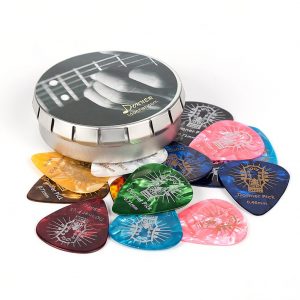 Made of celluloid material, these picks come in packs of 16 with a variety of sizes from thin and medium to heavy. Available in over 8 colors and designs, their shape is perfect to give you good grip and ease of control. The natural feel of celluloid helps in giving out a fat tone from the instrument.
Made of celluloid material, these picks come in packs of 16 with a variety of sizes from thin and medium to heavy. Available in over 8 colors and designs, their shape is perfect to give you good grip and ease of control. The natural feel of celluloid helps in giving out a fat tone from the instrument.
Pros
- Celluloid material
- Variety of sizes included in the pack
- Comes with a complementary container box
Cons
- Little expensive
12. BlueSkyCreations
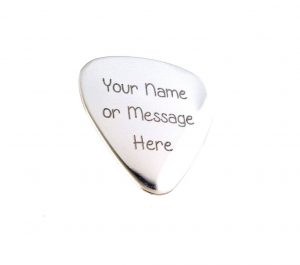 Made of stainless steel, these are custom picks of 22 gauge that can be customized to make a stamp of your name or message on the pick.
Made of stainless steel, these are custom picks of 22 gauge that can be customized to make a stamp of your name or message on the pick.
Pros
- Customizable
- Great gift item
- Easy to order online
Cons
- Only one-sided stamping is possible
13. Zhovee
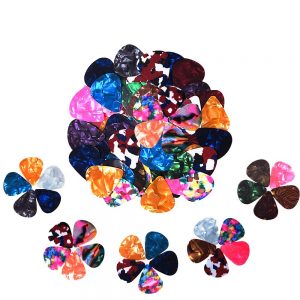 Made of high-quality celluloid, these are extremely durable picks available in three different sizes for different purposes. Being light in weight and thin in gauge, they fit on your fingers well and allow you to play your instrument comfortably.
Made of high-quality celluloid, these are extremely durable picks available in three different sizes for different purposes. Being light in weight and thin in gauge, they fit on your fingers well and allow you to play your instrument comfortably.
Pros
- Variety of sizes included in the pack of 60
- Attractive design
- Inexpensive
- Light weight
- Durable
Cons
- Random colors are shipped. Buyers cannot choose their favorite colors
14. Celluloid Catholic Theme
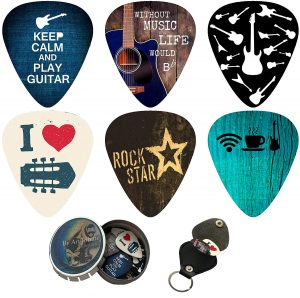 Made of celluloid, these are medium sized guitar picks that are designed with catholic art as their theme. They fit perfectly in your fingers and allow you to produce warm mellow tones from your instrument. You also get a click clack box and a leather pick holder along with the picks.
Made of celluloid, these are medium sized guitar picks that are designed with catholic art as their theme. They fit perfectly in your fingers and allow you to produce warm mellow tones from your instrument. You also get a click clack box and a leather pick holder along with the picks.
Pros
- Excellent gift item
- Pack of 12
- Beautiful catholic inspired designs
Cons
- Little expensive
15. Haneye
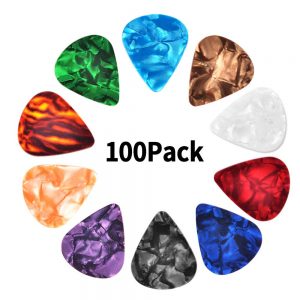 This pack has 100 picks of various sizes made of standard celluloid. Wide body and round tip of the picks allow you to hold the pick comfortably and produce classic tones from your instrument.
This pack has 100 picks of various sizes made of standard celluloid. Wide body and round tip of the picks allow you to hold the pick comfortably and produce classic tones from your instrument.
Pros
- Fit in the fingers well
- Available in a variety of attractive colors and designs
- Several sizes included in the pack
- Suitable for different types of guitars
Cons
- No option to select colors
How To Use A Pick?
Using a guitar pick is one of the most important lessons given while learning how to play the guitar. If a musician does not properly learn the technique of holding and using a pick, it can be a huge inconvenience for the guitar player during a show or a performance.
Only getting the best pick for your performances is not enough. A strong foundation of a guitar player is ensured through the proper and efficient use of a plectrum.
The most simple and conventional way to describe the technique of holding a guitar pick is by making an “OK” sign with the thumb and index fingers. Holding the pick in such a way that the edge or the pointed end is facing downwards or towards the instrument.
This technique is the most common one used to master the art of holding a pick. It ensures that a player’s hand and wrist are in the proper angle to facilitate maximum flexibility and ability to properly navigate through the strings of the guitar.
The pick should be held in a comfortable grip between the fingers, and too much rigidity or looseness must be avoided.
This enables proper grip and room of movement without compromising the flexibility and without having the risk of the plectra falling out of the hands of the musician. This helps the guitar player surf through the rhythm of the music and efficiently execute the little nuances of guitar playing.
FAQs on Guitar Picks
1. Should A Beginner Guitar Player Use A Pick?
Whether you are using an acoustic guitar or an electric one, if your guitar has steel strings, you should develop the habit of using a pick from the very beginning.
Picks are very effective in playing melodic and lead guitar passages, as you can strike the notes more perfectly using a pick rather than doing that with fingers.
2. Which Guitar Pick Is The Best For Beginners?
If you are a beginner guitar player, go for a lighter pick that is less than 0.46 mm thick. It is thin, the music produced with this pick sounds rich, it gives a beautiful zing across the guitar strings, and it is very easy to control as well.
3. What Is A Guitar Pick Formally Named As?
The formal name of a guitar pick is a plectrum.
4. How Long Does A Guitar Pick Last?
How long your pick lasts depends on your guitar strings, your style of playing, and how frequently you use it. with regular use, a pick is expected to last around 2 weeks.
It may be still be used, but you will notice a difference in its usage and music quality. However, it becomes completely useless in 3 weeks.
Influence Your Music Style With Your Choice Of Guitar Picks
By now, you must have understood that there is a wide range of different pick styles available in the market, each serving a different purpose, suitable for a particular music style, and as per the guitarist’s playing style.
Based on the applications and the preferences of certain musicians, they use different kinds of guitar picks for different types of instruments and music tones.
In the above sections, we have explained about certain factors that must be considered while choosing guitar picks.
Although they are tiny pieces, they play a great role in producing the desired kind of music from your instrument. So, be informed and select the best guitar picks as per your personal requirements and preferences.

